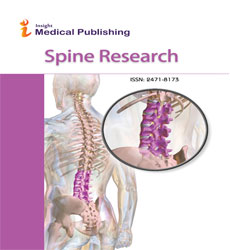Degenerative Disc Disease: Current Understanding and Emerging Therapies
Haziq Aina
Published Date: 2025-02-28Haziq Aina *
Department of Neurosurgery, University of Virginia School of Medicine, Charlottesville, VA 22903, USA
*Corresponding author:
Haziq Aina,
Department of Neurosurgery, University of Virginia School of Medicine, Charlottesville, VA 22903, USA,
E-mail: aina.haziq@virginia.edu
Received date: February 01, 2025, Manuscript No. ipsr-25-20625; Editor assigned date: February 03, 2025, PreQC No. ipsr-25-20625 (PQ); Reviewed date: February 15, 2025, QC No. ipsr-25-20625; Revised date: February 22, 2025, Manuscript No. ipsr-25-20625 (R); Published date: February 28, 2025, DOI: 10.36648/ 2471-8173.11.1.02
Citation: Aina H (2025) Degenerative Disc Disease: Current Understanding and Emerging Therapies. Spine Res Vol.11 No.1:02
Introduction
Degenerative Disc Disease (DDD) is a prevalent condition of the spine characterized by progressive structural and functional deterioration of the intervertebral discs. Affecting a significant portion of the adult population, particularly those over the age of 40, DDD is a major contributor to chronic back pain, reduced mobility and impaired quality of life. The intervertebral disc is a complex fibrocartilaginous structure consisting of the nucleus pulposus, annulus fibrosus and cartilaginous endplates, which together provide flexibility, load-bearing capacity and shock absorption for the spinal column. Degeneration of these components leads to biomechanical instability, nerve compression and inflammatory responses, contributing to pain and functional limitations. Understanding the pathophysiology of DDD, including molecular, cellular and biomechanical factors, is essential for the development of effective diagnostic and therapeutic strategies. Recent advances in regenerative medicine, biologics and tissue engineering have opened new avenues for the treatment of DDD, complementing traditional conservative and surgical approaches [1].
Description
The pathogenesis of degenerative disc disease is multifactorial, involving mechanical stress, aging, genetic predisposition, biochemical alterations and inflammatory processes. Intervertebral discs are avascular structures with limited regenerative capacity, relying on diffusion through the endplates for nutrient supply. With aging or repeated mechanical stress, the disc matrix undergoes changes, including loss of proteoglycans, reduced water content in the nucleus pulposus and weakening of the annulus fibrosus. These changes compromise disc hydration, elasticity and load distribution, increasing the risk of fissures, herniation and annular tears. Biomechanical instability resulting from disc degeneration further accelerates spinal degeneration, promoting facet joint arthropathy and spondylosis [2].
Inflammation is a central component of DDD, with degenerating discs producing pro-inflammatory cytokines such as Tumor Necrosis Factor-alpha (TNF-ñ), InterLeukin-1 beta (IL-1ò) and InterLeukin-6 (IL-6). These mediators induce catabolic pathways in disc cells, promote matrix degradation and sensitize nerve endings, contributing to pain. Additionally, neovascularization and nerve ingrowth into previously aneural regions of the disc exacerbate nociceptive signaling. Immune cell infiltration, including macrophages and T lymphocytes, further amplifies local inflammation, linking degenerative changes to chronic pain syndromes. Genetic factors, such as polymorphisms in genes encoding collagen, aggrecan and matrix metalloproteinases, influence susceptibility to disc degeneration and pain perception [1].
Clinical presentation of DDD varies widely, ranging from asymptomatic structural changes to severe, debilitating back pain radiating to the lower extremities. Common symptoms include axial back pain, stiffness, limited range of motion and radicular pain due to nerve root compression. Diagnosis relies on a combination of clinical evaluation and imaging techniques. Magnetic Resonance Imaging (MRI) is the gold standard, providing detailed assessment of disc hydration, structural integrity and adjacent tissue involvement. Computed Tomography (CT) and X-rays may be used to evaluate bony changes and vertebral alignment. Biomarkers of inflammation and degeneration are also being investigated as adjuncts for early detection and monitoring of disease progression.
Conservative management remains the first-line approach for DDD, focusing on symptom relief, functional restoration and prevention of further degeneration. Physical therapy emphasizes core strengthening, flexibility and postural correction to reduce mechanical stress on the spine. Pharmacological treatments include non-steroidal anti-inflammatory drugs (NSAIDs), analgesics, muscle relaxants, and, in select cases, corticosteroid injections to control pain and inflammation. Lifestyle modifications, such as weight management, smoking cessation and ergonomic adjustments, are critical for reducing mechanical load and enhancing disc health. Surgical intervention is considered for patients with refractory pain, neurological deficits, or spinal instability. Common procedures include spinal fusion, discectomy and artificial disc replacement. Spinal fusion stabilizes the affected segment but may limit mobility and increase stress on adjacent discs, potentially accelerating degeneration. Artificial disc replacement aims to preserve motion while relieving pain, but long-term outcomes and device longevity remain areas of ongoing research.
Conclusion
Degenerative disc disease is a complex disorder driven by biomechanical, cellular and inflammatory processes that compromise spinal structure and function, resulting in pain and disability. Current management strategies focus on symptom control, functional restoration and surgical stabilization when necessary. Emerging therapies, including cell-based interventions, gene therapy, tissue engineering and biologics, offer promising avenues for regenerating disc tissue, modulating inflammation and improving patient outcomes. Integration of biomechanical insights, molecular understanding and personalized approaches is essential for optimizing treatment efficacy and minimizing complications. Preventive strategies, early diagnosis and targeted regenerative therapies hold the potential to transform the management of degenerative disc disease, improving quality of life and long-term spinal health for affected individuals.
Acknowledgement
None.
Conflict of Interest
None.
References
- Karppinen J, Shen FH, Luk KD, Andersson GB and Cheung KM, et al. (2011) Management of degenerative disk disease and chronic low back pain. Orthop Clin North Am 42: 513-528.
Google Scholar Cross Ref Indexed at
- Bertagnoli R and Kumar S (2002) Indications for full prosthetic disc arthroplasty: A correlation of clinical outcome against a variety of indications. Eur Spine J 11: S131-136.
Google Scholar Cross Ref Indexed at
Open Access Journals
- Aquaculture & Veterinary Science
- Chemistry & Chemical Sciences
- Clinical Sciences
- Engineering
- General Science
- Genetics & Molecular Biology
- Health Care & Nursing
- Immunology & Microbiology
- Materials Science
- Mathematics & Physics
- Medical Sciences
- Neurology & Psychiatry
- Oncology & Cancer Science
- Pharmaceutical Sciences
